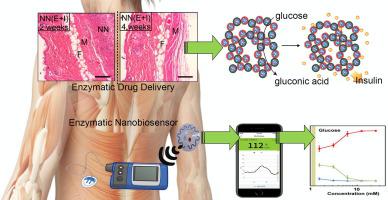Journal of Advanced Research ( IF 11.4 ) Pub Date : 2021-02-04 , DOI: 10.1016/j.jare.2021.01.012 Suliman Khan 1 , Mohammad Mahdi Nejadi Babadaei 2 , Anwarul Hasan 3, 4 , Zehra Edis 5, 6 , Farnoosh Attar 7 , Rabeea Siddique 1 , Qian Bai 8 , Majid Sharifi 9, 10, 11 , Mojtaba Falahati 10

|
Background
Because enzymes can control several metabolic pathways and regulate the production of free radicals, their simultaneous use with nanoplatforms showing protective and combinational properties is of great interest in the development of therapeutic nano-based platforms. However, enzyme immobilization on nanomaterials is not straightforward due to the toxic and unpredictable properties of nanoparticles in medical practice.
Aim of review
In fact, because of the ability to load enzymes on nano-based supports and increase their renewability, scientific groups have been tempted to create potential therapeutic enzymes in this field. Therefore, this study not only pays attention to the therapeutic and diagnostic applications of diseases by enzyme–nanoparticle (NP) bio-conjugate (abbreviated as: ENB), but also considers the importance of nanoplatforms used based on their toxicity, ease of application and lack of significant adverse effects on loaded enzymes. In the following, based on the published reports, we explained that the immobilization of enzymes on polymers, inorganic metal oxide and hybrid compounds provide hopes for potential use of ENBs in medical activities. Then, the use of ENBs in bioassay activities such as paper-based or wearing biosensors and lab-on-chip/microfluidic biosensors were evaluated. Finally, this review addresses the current challenges and future perspective of ENBs in biomedical applications.
Key scientific concepts of review
This literature may provide useful information regarding the application of ENBs in biosensing and therapeutic platforms.
中文翻译:

酶-聚合物/无机金属氧化物/混合纳米颗粒生物结合物在治疗和生物传感平台开发中的应用
背景
由于酶可以控制多种代谢途径并调节自由基的产生,因此它们与具有保护性和组合特性的纳米平台的同时使用在治疗性纳米平台的开发中引起了极大的兴趣。然而,由于纳米颗粒在医学实践中具有毒性和不可预测的特性,酶在纳米材料上的固定化并不简单。
审查目的
事实上,由于能够将酶负载在纳米载体上并提高其可再生性,科学团体一直试图在该领域创造潜在的治疗酶。因此,本研究不仅关注酶-纳米颗粒(NP)生物结合物(缩写为:ENB)在疾病的治疗和诊断方面的应用,而且还考虑了纳米平台基于其毒性、易用性和安全性的重要性。对负载的酶没有显着的不利影响。下面,根据已发表的报告,我们解释了酶在聚合物、无机金属氧化物和杂化化合物上的固定化为 ENB 在医疗活动中的潜在应用带来了希望。然后,评估了 ENB 在生物测定活动中的使用,例如纸基或佩戴生物传感器和芯片实验室/微流体生物传感器。最后,本综述讨论了 ENB 在生物医学应用中当前的挑战和未来前景。
审查的关键科学概念
该文献可能提供有关 ENB 在生物传感和治疗平台中应用的有用信息。











































 京公网安备 11010802027423号
京公网安备 11010802027423号